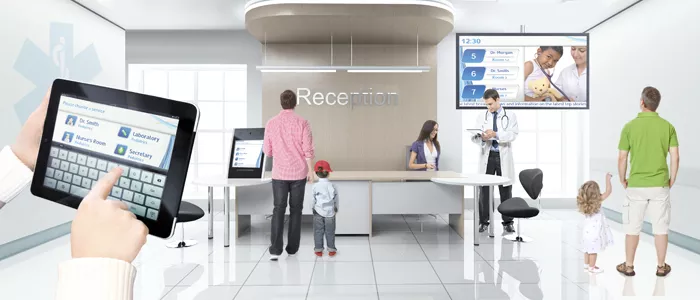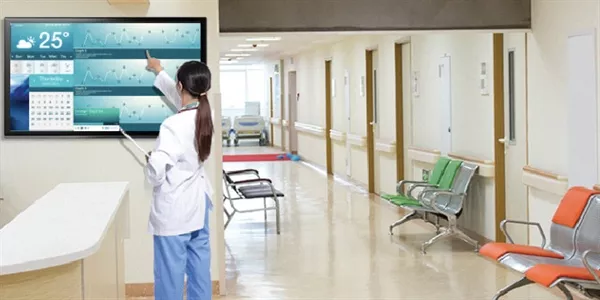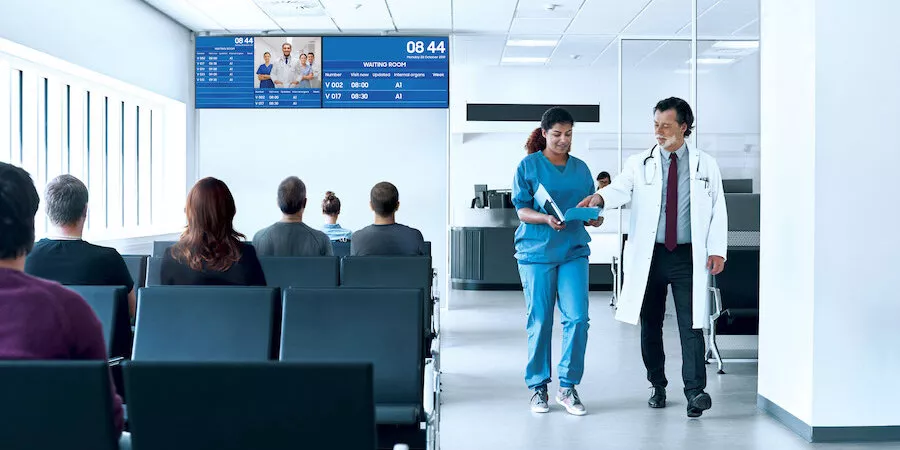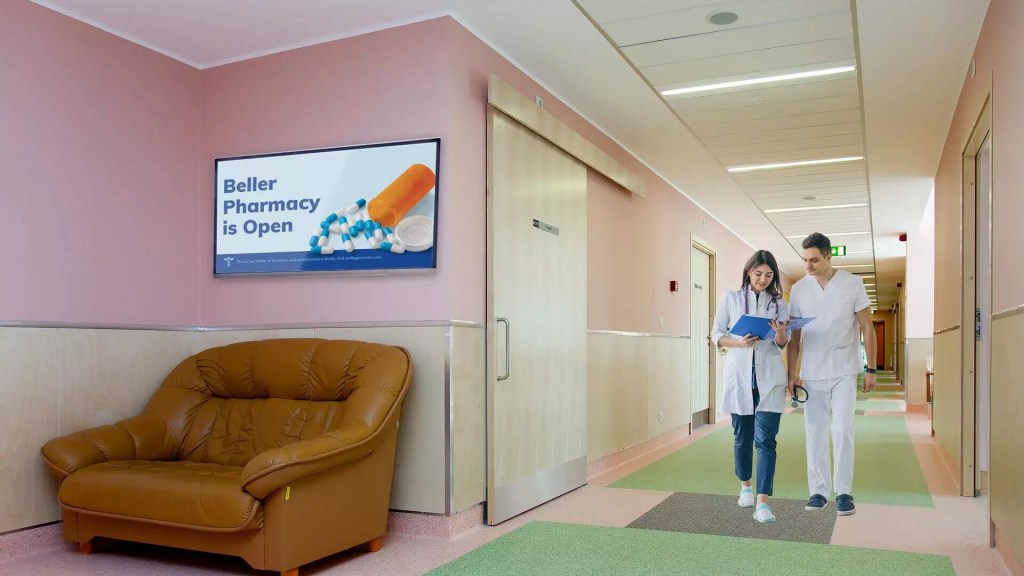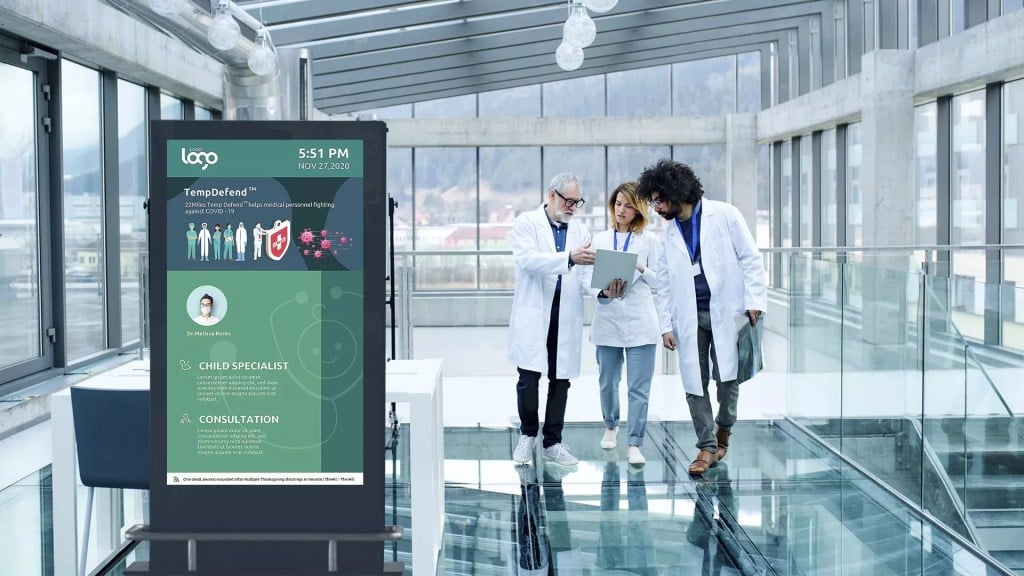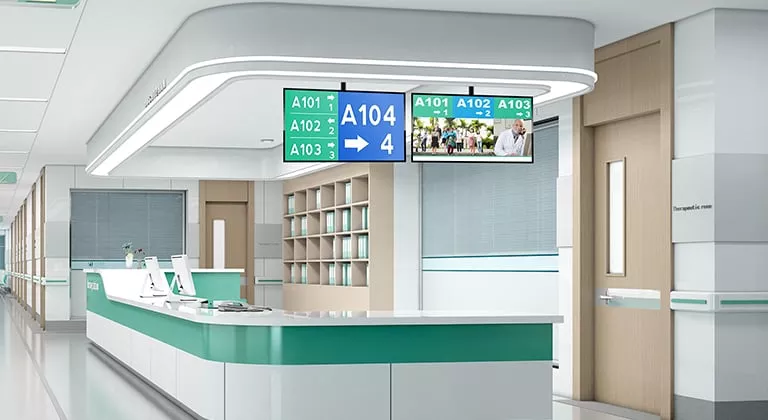7 benefits of digital signage in healthcare
To improve the patient experience, hospitals and healthcare clinics rely on clear, easily accessible communication—which also promotes more positive health outcomes and increases organizational brand awareness. Today, the most effective and efficient way to convey important real-time healthcare information is through digital signage.
Below are some of the applications and benefits of using digital signage solutions in hospitals.
1. Guide customers to their destination
Hospitals are large, busy places that can be daunting to navigate, especially when patients are trying to keep their appointments on time. Busy healthcare providers are often stopped and asked for directions. These wayfinding disruptions cost the hospital approximately $220,000 per year, not to mention the negative impact on the patient experience.
Digital wayfinding signage with touchscreen capabilities allows visitors to get their own directions, customized to where they need to go. Self-guided wayfinding frees hospital staff from directing traffic — and reduces the need for close interaction in hallways, which is especially worrisome during a virus outbreak.
2. Provide personalized patient care
Patient education and engagement is a hospital’s top priority. The more patients understand their health needs and commit to recovery, the better their care teams can deliver better health outcomes. In recent years, hospitals have placed greater emphasis on patient-centered care and shared decision-making — which can help improve the patient experience and reduce readmissions. The digital signage board reimagines the traditional patient room. Traditional paper bulletins and dry erase boards require constant manual updating during a patient’s stay.
Replacing these inefficient solutions with digital displays makes it easier to personalize and update patient information such as their most recent vitals, their room phone number, and the name and photo of their care team.
3. Reduce waiting room anxiety
No one likes to wait, but it’s even harder when you’re sick or waiting for a loved one to be discharged from the hospital. Digital signage in waiting rooms alleviates some anxiety by showing expected wait times and providing engaging content that is both distracting and educational.In surgery waiting rooms, digital signage display can share status updates with family members, using assigned numbers rather than names to protect patient privacy. Family members can see exactly when their loved one entered the operating room, how long they were there and when they were transferred to the recovery room. The digital signage updates in real time, reducing anxiety for patients’ families and freeing hospital staff to focus on providing the best care possible.
4. Real-time communication with visitors
Hospitals have vital information to communicate with patients and visitors – whether it’s emergency safety announcements, advice or tips, hospital services and events, or general health awareness.
Digital signage solutions enable hospitals to more strategically determine what information to share and when and where to share it. Information is easily updated digitally, and in an emergency, administrators can push real-time security alerts. In the event of an infectious disease outbreak, when the CDC regularly updates its safety protocols and guidelines, electronic signage can quickly communicate the latest information to visitors and staff.
Lobby digital displays can also help tell your organization’s story. Physician profiles, patient stories and testimonials played on animated displays inspire confidence in the facility. The same displays can inform patients about available amenities, innovative medical practices, and answers to other frequently asked questions.
In a hospital cafeteria, digital screen makes updating menus quick and easy.
Instead of writing on a blackboard or reprinting flyers, employees can instantly update daily specials, remove sold-out items, change prices, and make other adjustments on the fly.
5. Celebrate your donors and boost your income
6. Sharing information among hospital staff
Doctors and nurses can use digital signage to quickly share important patient information without paper charts or bulky folders. For example, a small patient information digital screen located outside a patient room might list a patient’s allergies and other applicable health warnings, such as fall risk or isolation.
Nursing stations can use digital signage to inform staff of who is currently on duty, upcoming shift schedules, and which nurses should be matched with specific patients based on language preference.
7. Improve diagnosis speed
One of the biggest benefits of digital signage in hospitals is the ability to diagnose patients more effectively. Widescreen displays provide a larger canvas so doctors and nurses can view everything from X-rays to EHRs more quickly. The enhanced resolution helps doctors view X-rays, CT scans and other visual information more accurately.
Meanwhile, the interactive whiteboard allows physicians to digitally annotate patient images. With just a few taps, these annotations can be downloaded and sent to the patient or other members of their care team. Physicians save the time they would have spent switching between windows and flipping through notes, allowing for faster diagnoses and improving the overall patient experience.
